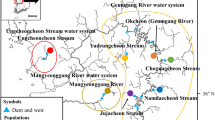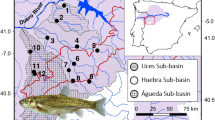Abstract
In regions with high biodiversity, where species are exploited as a source of income, it is essential to learn more about the species that are being commercialized. For the ornamental fish black arowana (Osteoglossum ferreirai), distributed only in Colombia and Brazil, there is currently a lack of information about population estimates in each location, genetic data and lastly, about the events that lead to the current distribution of the species. A genetic population study was conducted by sequencing the mitochondrial genes cytochrome b and ATPase 6, and genotyping of eight microsatellite loci. Mitochondrial gene results indicated the absence of variable sites, and the microsatellite results showed a significantly lower heterozygosity than expected demonstrating that currently the genetic diversity of the species is low. The fact that this species is been exploited and that it shows low genetic diversity means it can quickly become endangered. For this reason, conservation, management and use programs for the black arowana should include and consider the genetic data obtained as well as additional life history and ecological factors to promote its sustainable use.


Similar content being viewed by others
References
Agudelo-Zamora HD, Lopez-Macia JN, Sanchez-Paez CL (2007) Hábitos alimentarios de la arawana (Osteoglossum bicirrhosum, Vandelli, 1829) (Pisces: Osteoglossidae) en el alto río putumayo, área del parque nacional natural la paya, putumayo. Acta Biológica Colombiana 36:91–101
Argumedo E, Lopez JN, Sanchez-Paez C (2006) Sistemas de Producción de Arawanas Suramericanas, Una Alternativa de Aprovechamiento Sostenible de la Biodiversidad Ictica y de Fortalecimiento de la Acuicultura Amazónica, vol 2. Revista Electrónica de Ingeniería en Producción Acuícola
Banguera-Hinestroza E, Cardenas H, Ruiz-Garcia M, Marmontel M, Gaitan E, Vazquez R, Garcia-Vallejo F (2002) Molecular identification of evolutionarily significant units in the Amazon river dolphin Inia sp. (Cetacea: Iniidae). J Hered 93:312–322
Cala P (1973) Presencia de Osteoglossum en los Llanos (Orinoquia). Acta Zool Colombiana
CCI (2009) Sistema de información de pesca y acuicultura boletín mensual. Servicio de Información Agropecuaria. http://www.cci.org.co/cci/cci_x/datos/BoletinesIncoder/Mensual/BolMay2009.pdf. Accessed 23 May 2012
Cena CJ, Morgan GE, Malette MD, Heath DD (2006) Inbreeding, outbreeding and environmental effects on genetic diversity in 46 walleye (Sander vitreus) populations. Mol Ecol 15(2):303–320. doi:10.1111/j.1365-294X.2005.02637.x
DaSilva T (2009) Marcadores moleculares para análise da variabilidade genética de populações do aruanã (Osteoglossum bicirrhosum). Disertation, Universidade Federal do Amazonas
DaSilva T, Hrbek T, Farias I (2009) Microsatellite markers for the silver arowana (Osteoglossum bicirrhosum, Osteoglossidae, Osteoglossiformes). Mol Ecol Resour 9(3):1019–1022. doi:10.1111/j.1755-0998.2009.02556.x
Dawson MN, Louie KD, Barlow M, Jacobs DK, Swift CC (2002) Comparative phylogeography of sympatric sister species, Clevelandia ios and Eucyclogobius newberryi (teleostei, gobiidae), across the California transition zone. Mol Ecol 11:1065–1075
Doyle JJ, Doyle JL (1987) A rapid DNA isolation procedure for small quantities of fresh leaf tissue. Phytochem Bull 19:11–15
Drummond AJ, Ashton B, Buxton S, Cheung M, Cooper A, Duran C, Field M, Heled J, Kearse M, Markowitz S, Moir R, Stones-Havas S, Sturrock S, Thierer T, Wilson A (2009) Geneious v 4.7
Duncan WP, Fernandes MN (2010) Physicochemical characterization of the white, black, and clearwater rivers of the Amazon Basin and its implications on the distribution of freshwater stingrays (chondrichthyes, potamotrygonidae). Panamjas 5(3):454–464
Earl D, vonHoldt B (2012) STRUCTURE HARVESTER: a website and program for visualizing structure output and implementing the evanno method. Conserv Genet Resour 4(2):359–361
Escobar MD, Farias IP, Taphorn DC, Landines BM, Hrbek T (2012) Molecular diagnosis of the arowanas Osteoglossum ferreirai Kanazawa, 1996 and O. bicirrhossum (Cuvier, 1829) from the orinoco and Amazon river basins, unpublished manuscript
Evanno G, Regnaut S, Goudet J (2005) Detecting the number of clusters of individuals using the software STRUCTURE: a simulation study. Mol Ecol 14(8):2611–2620. doi:10.1111/j.1365-294X.2005.02553.x
Excoffier L, Laval G, Schneider S (2005) An integrated software package for population genetics data analysis. Evol Bioinform 1:47–50
Falla P, Poveda J (2008) Contribución a la gestión sostenible y al conocimiento biológico y socio económico de la cadena de valor de peces ornamentales de puerto carreño, reserva de biosfera el tuparo (Vichada-Colombia). Fundación Omacha-Fundación Horizonte Verde, Bogota
Funk WC, McKay JK, Hohenlohe PA, Allendorf FW (2012) Harnessing genomics for delineating conservation units. Trends Ecol Evol 27(9):489–496
Hrbek T, Farias IP, Crossa M, Sampaio I, Porto JIR, Meyer A (2005) Population genetic analysis of Arapaima gigas, one of the largest freshwater fishes of the Amazon basin: implications for its conservation. Anim Conserv 8(3):297–308. doi:10.1017/s1367943005002210
Hubert N, Renno JF (2006) Historical biogeography of South American freshwater fishes. J Biogeogr 33:1414–1436
Hundertmark KJ, Van Daele LJ (2010) Founder effect and bottleneck signatures in an introduced, insular population of elk. Conserv Genet 11:139–147
Junk W, Soares MGM, Bayley P (2007) Freshwater fishes of the Amazon river basin: their biodiversity, fisheries and habitats. Aquat Ecosyst Health Manage 10(2):153–173
Kalinowski S (2004) Counting alleles with rarefaction: private alleles and hierarchical sampling design. Conserv Genet 5:539–543
Kanazawa RH (1966) The Fishes of the genus Osteoglossum with a description of a new species from the Rio Negro. Ichthyol Aquarium J 37(4):161–172
Kocher TD, Thomas WK, Meyer A, Edwards SV, Pääbo S, Villablanca FX, Wilson AC (1989) Dynamics of mitochondrial DNA evolution in animals: amplification and sequencing with conserved primers. Nat Acad Sci Proc 86(16):6196–6200
Lovejoy NR, De Araújo MLG (2000) Molecular systematics, biogeography and population structure of neotropical freshwater needlefishes of the genus Potamorrhaphis. Mol Ecol 9(3):259–268. doi:10.1046/j.1365-294x.2000.00845.x
Luikart G, Sherwin WB, Steele BM, Allendorf FW (1998) Usefulness of molecular markers for detecting population bottlenecks via monitoring genetic change. Mol Ecol 7(8):963–974. doi:10.1046/j.1365-294x.1998.00414.x
Lundberg JG, Marshall LG, Guerrero J (1998) The stage for neotropical fish diversification: a history of tropical South American rivers. In: Malabarba LR RR, Vari RP, Lucena ZMS, Lucena CAS (eds) Phylogeny and Classification of Neotropical Fishes. Edipucrs, Porto Alegre
Maldonado-Ocampo JA, Vari RP, Usma JS (2008) Checklist of the freshwater fishes of Colombia. Biota Colombiana 9(2):143–237
Mancera-Rodriguez N, Alvarez-Leon R (2008) Comercio de peces ornamentales en Colombia. Acta Biologica Colombiana 13(1):23–52
Matschiner M, Salzburger W (2009) TANDEM: integrating automated allele binning into genetics and genomics workflows. Bioinformatics 25(15):1982–1983. doi:10.1093/bioinformatics/btp303
Mojica JI, Castellanos C, Usma JS, Alvarez R (eds) (2002) Libro rojo de peces dulceacuícolas de Colombia. Bogota, Colombia
Mojica JI, Usma JS, Lasso RÁ-LCA (2012) Libro rojo de peces dulceacuícolas de Colombia. Bogotá, Colombia
Moreau M-A, Coomes OT (2007) Aquarium fish exploitation in western Amazonia: conservation issues in Peru. Environ Conserv 34:12–22
Moritz C (1994) Defining ‘evolutionary significant units’ for conservation. Tree 9(10):373–375
Piry S, Gordon L, Cornuet JM (1999) Bottleneck: a computer program for detecting recent reduction in the effective population size using allele frequency data. J Hered 90:502–503
Pritchard JK, Stephens M, Donnelly P (2000) Inference of population structure using multilocus genotype data. Genetics 155(2):945–959
Rabello-Neto JG (1999) Biologia reproductiva e alimentação natural do aruanã preta O. ferreirai (Kanazawa, 1966), no municipio de Barcelos, médio Rio Negro, Amazonas, Brasil. Disertation. Universidade do Amazonas
Reis RE, Lima F (2009) Osteoglossum ferreirai IUCN Red List of Threatened Species. www.iucnredlist.org
Reis RE, Kullander SO, Ferraris CJ (2004) Checklist of freshwater fishes of South and Central America Porto Alegre
Tang M (2002) Plan de manejo de recursos pesqueros. Iquitos, Peru
Tang PY, Sivananthan J, Pillay SO (2004) Genetic structure and biogeography of asian arowana (Scleropages formosus) determined by microsatellite and mitochondrial DNA analysis. Asian Fish Sci 17:81–92
Van Oosterhout C, Hutchinson WF, Wills DPM, Shipley P (2004) Micro-checker: software for identifying and correcting genotyping errors in microsatellite data. Mol Ecol Notes 4(3):535–538. doi:10.1111/j.1471-8286.2004.00684.x
Willis SC, Nunes M, Montaña CG, Farias IP, Ortí G, Lovejoy NR (2010) The Casiquiare river acts as a corridor between the Amazonas and orinoco river basins: biogeographic analysis of the genus Cichla. Mol Ecol 19(5):1014–1030
Winemiller KO, Lopez-Fernandez H, Taphorn DC, Nico LG, Duque AB (2008) Fish assemblages of the Casiquiare river, a corridor and zoogeographical filter for dispersal between the orinoco and Amazon basins. J Biogeogr 35:1551–1563
Yue GH, Ong D, Wong CC, Lim LC, Orban L (2003) A strain-specific and a sex-associated STS marker for Asian arowana (Scleropages formosus, Osteoglossidae). Aquacult Res 34(11):951–957. doi:10.1046/j.1365-2109.2003.00949.x
Zucchi MI, Vianello Brondani RP, Pinheiro JB, Chaves LJ, Guedes Coelho AS, Vencovsky R (2003) Genetic structure and gene flow in Eugenia dysenteria DC in the Brazilian Cerrado utilizing SSR markers. Gen Mol Biol 26(4):449–457
Acknowledgments
We are grateful to P. Falla and L. Carillo, as well as to Incoder (Instituto Colombiano de Desarrollo Rural) and Fundación Omacha in Puerto Carreño for their help with sample collection in the Colombian orinoco. We thank Cristian Salinas and the fishermen in Barcelos that help us with the sample collection in Brazil. Special thanks go to I. Farias and the LEGAL laboratory member for their help with fieldwork logistics and laboratory access in Brazil. We are thankful for all the financial support for this project that was provided by Incoder (through Fundación Omacha), to a Colombia Biodiversa granrt from Fundación Alejandro Angel Escobar, to the grant of Especies Amenazadas from the Fundacion Omacha and Proyecto Semilla from faculty of science from the Universidad de los Andes.
Author information
Authors and Affiliations
Corresponding author
Rights and permissions
About this article
Cite this article
Olivares, A.M., Hrbek, T., Escobar, M.D. et al. Population structure of the black arowana (Osteoglossum ferreirai) in Brazil and Colombia: implications for its management. Conserv Genet 14, 695–703 (2013). https://doi.org/10.1007/s10592-013-0463-1
Received:
Accepted:
Published:
Issue Date:
DOI: https://doi.org/10.1007/s10592-013-0463-1




